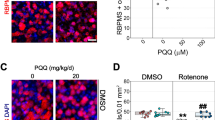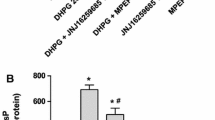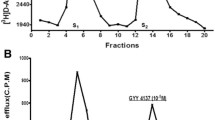Abstract
Ascorbate, the reduced form of vitamin C, is highly concentrated in the central nervous system (CNS), including the retina, where it plays important physiological functions. In the CNS, the plasma membrane transporter sodium vitamin C co-transporter 2 (SVCT2) is responsible for ascorbate transport in neurons. The neurotransmitter dopamine (DA), acting through D1- and D2-like receptor subfamilies and classically coupled to adenylyl cyclase, is known to modulate synaptic transmission in the retina. Here, we reveal that DA controls the release of ascorbate from retinal neurons. Using primary retinal cultures, we show that this DA effect is dose-dependent, occurring by the reversal of the SVCT2, and could be elicited by brief and repetitive pulses of DA. The DA effect in inducing ascorbate release occurs by the activation of D1R and is independent of PKA. Moreover, the exchange protein directly activated by cAMP type 2 (EPAC2) is present in retinal neurons and its specific knockdown using shRNAs abrogates the D1R-induced ascorbate release. Confirming the physiological relevance of this pathway, activation of D1R or EPAC2 also triggered ascorbate release ex vivo in acute preparations of the intact retina. Overall, DA plays pivotal roles in regulating ascorbate homeostasis through an unanticipated signaling pathway involving D1R/adenylyl cyclase/cAMP/EPAC2, thereby suggesting that vitamin C might fine-tune dopaminergic neurotransmission in the retina.







Similar content being viewed by others
References
Wilson JX (2005) Regulation of vitamin C transport. Annu Rev Nutr 25:105–125
Rice ME (2000) Ascorbate regulation and its neuroprotective role in the brain. Trends Neurosci 23(5):209–216
Eipper BA, Mains RE, Glembotski CC (1983) Identification in pituitary tissue of a peptide alpha-amidation activity that acts on glycine-extended peptides and requires molecular oxygen, copper, and ascorbic acid. Proc Natl Acad Sci U S A 80(16):5144–5148
Eldridge CF, Bunge MB, Bunge RP (1989) Differentiation of axon-related Schwann cells in vitro: II. Control of myelin formation by basal lamina. J Neurosci 9(2):625–638
Eldridge CF, Bunge MB, Bunge RP, Wood PM (1987) Differentiation of axon-related Schwann cells in vitro. I. Ascorbic acid regulates basal lamina assembly and myelin formation. J Cell Biol 105(2):1023–1034
Qiu S, Li L, Weeber EJ, May JM (2007) Ascorbate transport by primary cultured neurons and its role in neuronal function and protection against excitotoxicity. J Neurosci Res 85(5):1046–1056
Rebec GV, Pierce R (1994) A vitamin as neuromodulator: ascorbate release into the extracellular fluid of the brain regulates dopaminergic and glutamatergic transmission. Prog Neurobiol 43(6):537–565
Harrison FE, May JM (2009) Vitamin C function in the brain: vital role of the ascorbate transporter SVCT2. Free Radic Biol Med 46(6):719–730. https://doi.org/10.1016/j.freeradbiomed.2008.12.018
Rice ME, Russo-Menna I (1998) Differential compartmentalization of brain ascorbate and glutathione between neurons and glia. Neuroscience 82(4):1213–1223
Daruwala R, Song J, Koh WS, Rumsey SC, Levine M (1999) Cloning and functional characterization of the human sodium-dependent vitamin C transporters hSVCT1 and hSVCT2. FEBS Lett 460(3):480–484
Tsukaguchi H, Tokui T, MacKenzie B, Berger UV, Chen XZ, Wang Y, Brubaker RF, Hediger MA (1999) A family of mammalian Na+-dependent L-ascorbic acid transporters. Nature 399:70–75
Savini I, Rossi A, Pierro C, Avigliano L, Catani M (2008) SVCT1 and SVCT2: key proteins for vitamin C uptake. Amino Acids 34(3):347–355
Clemens JA, Phebus LA (1984) Brain dialysis in conscious rats confirms in vivo electrochemical evidence that dopaminergic stimulation releases ascorbate. Life Sci 35(6):671–677
Pierce RC, Rebec GV (1990) Stimulation of both D1 and D2 dopamine receptors increases behavioral activation and ascorbate release in the neostriatum of freely moving rats. Eur J Pharmacol 191(3):295–302
Girault JA, Greengard P (2004) The neurobiology of dopamine signaling. Arch Neurol 61(5):641–644. https://doi.org/10.1001/archneur.61.5.641
Sidhu A, Niznik HB (2000) Coupling of dopamine receptor subtypes to multiple and diverse G proteins. Int J Dev Neurosci 18(7):669–677
Adinoff B (2004) Neurobiologic processes in drug reward and addiction. Harv Rev Psychiatry 12(6):305–320. https://doi.org/10.1080/10673220490910844
Koob GF, Le Moal M (2008) Neurobiological mechanisms for opponent motivational processes in addiction. Philos Trans R Soc Lond Ser B Biol Sci 363(1507):3113–3123. https://doi.org/10.1098/rstb.2008.0094
Missale C, Nash SR, Robinson SW, Jaber M, Caron MG (1998) Dopamine receptors: from structure to function. Physiol Rev 78(1):189–225
Oak JN, Oldenhof J, Van Tol HH (2000) The dopamine D(4) receptor: one decade of research. Eur J Pharmacol 405(1–3):303–327
de Rooij J, Zwartkruis FJ, Verheijen MH, Cool RH, Nijman SM, Wittinghofer A, Bos JL (1998) Epac is a Rap1 guanine-nucleotide-exchange factor directly activated by cyclic AMP. Nature 396(6710):474–477. https://doi.org/10.1038/24884
Kawasaki H, Springett GM, Mochizuki N, Toki S, Nakaya M, Matsuda M, Housman DE, Graybiel AM (1998) A family of cAMP-binding proteins that directly activate Rap1. Science 282(5397):2275–2279
De Mello M, Ventura A, Paes de Carvalho R, Klein W, De Mello F (1982) Regulation of dopamine-and adenosine-dependent adenylate cyclase systems of chicken embryo retina cells in culture. Proc Natl Acad Sci U S A 79(18):5708–5712
Paes-de-Carvalho R, de Mello F (1985) Expression of A1 adenosine receptors modulating dopamine-dependent cyclic AMP accumulation in the chick embryo retina. J Neurochem 44(3):845–851
Paes-de-Carvalho R, Braas KM, Snyder SH, Adler R (1990) Analysis of adenosine immunoreactivity, uptake, and release in purified cultures of developing chick embryo retinal neurons and photoreceptors. J Neurochem 55(5):1603–1611
Vergara MN, Canto-Soler MV (2012) Rediscovering the chick embryo as a model to study retinal development. Neural Dev 7:22. https://doi.org/10.1186/1749-8104-7-22
Witkovsky P (2004) Dopamine and retinal function. Doc Ophthalmol 108(1):17–40
Reis RAM, Ventura ALM, Kubrusly RCC, de Mello MCF, de Mello FG (2007) Dopaminergic signaling in the developing retina. Brain Res Rev 54(1):181–188
Ventura ALM, Klein WL, De Mello FG (1984) Differential ontogenesis of D1 and D2 dopaminergic receptors in the chick embryo retina. Brain Res Dev Brain Res 12(2):217–223
Lam KW, Zwaan J, Garcia A, Shields C (1993) Detection of ascorbic acid in the eye of the early chicken embryo by silver staining. Exp Eye Res 56(8500569):601–604
Portugal CC, Miya VS, Calaza KC, Santos RAM, Paes-de-Carvalho R (2009) Glutamate receptors modulate sodium-dependent and calcium-independent vitamin C bidirectional transport in cultured avian retinal cells. J Neurochem 108(2):507–520
Neal MJ, Cunningham JR, Matthews KL (1999) Release of endogenous ascorbic acid preserves extracellular dopamine in the mammalian retina. Invest Ophthalmol Vis Sci 40(12):2983–2987
May JM, Li L, Hayslett K, Qu ZC (2006) Ascorbate transport and recycling by SH-SY5Y neuroblastoma cells: response to glutamate toxicity. Neurochem Res 31(6):785–794. https://doi.org/10.1007/s11064-006-9077-z
McNulty AL, Vail TP, Kraus VB (2005) Chondrocyte transport and concentration of ascorbic acid is mediated by SVCT2. Biochim Biophys Acta 1712(2):212–221. https://doi.org/10.1016/j.bbamem.2005.04.009
Davis KA, Samson SE, Best K, Mallhi KK, Szewczyk M, Wilson JX, Kwan CY, Grover AK (2006) Ca2+-mediated ascorbate release from coronary artery endothelial cells. Br J Pharmacol 147(2):131–139. https://doi.org/10.1038/sj.bjp.0706492
Caprile T, Salazar K, Astuya A, Cisternas P, Silva-Alvarez C, Montecinos H, Millan C, de Los Angeles Garcia M et al (2009) The Na+-dependent L-ascorbic acid transporter SVCT2 expressed in brainstem cells, neurons, and neuroblastoma cells is inhibited by flavonoids. J Neurochem 108(3):563–577. https://doi.org/10.1111/j.1471-4159.2008.05788.x
Fisar Z, Hroudova J, Raboch J (2010) Inhibition of monoamine oxidase activity by antidepressants and mood stabilizers. Neuro Endocrinol Lett 31(5):645–656
Sibley DR, Leff SE, Creese I (1982) Interactions of novel dopaminergic ligands with D-1 and D-2 dopamine receptors. Life Sci 31(7):637–645
Bourne JA (2001) SCH 23390: the first selective dopamine D1-like receptor antagonist. CNS Drug Rev 7(4):399–414
Schlosshauer B, Grauer D, Dutting D, Vanselow J (1991) Expression of a novel Muller glia specific antigen during development and after optic nerve lesion. Development 111(3):789–799
Guellaen G, Mahu JL, Mavier P, Berthelot P, Hanoune J (1977) RMI 12330 A, an inhibitor of adenylate cyclase in rat liver. Biochim Biophys Acta 484(2):465–475
Seamon KB, Padgett W, Daly JW (1981) Forskolin: unique diterpene activator of adenylate cyclase in membranes and in intact cells. Proc Natl Acad Sci U S A 78(6):3363–3367
Staples KJ, Bergmann M, Tomita K, Houslay MD, McPhee I, Barnes PJ, Giembycz MA, Newton R (2001) Adenosine 3′,5′-cyclic monophosphate (cAMP)-dependent inhibition of IL-5 from human T lymphocytes is not mediated by the cAMP-dependent protein kinase A. J Immunol 167(4):2074–2080
Chijiwa T, Mishima A, Hagiwara M, Sano M, Hayashi K, Inoue T, Naito K, Toshioka T et al (1990) Inhibition of forskolin-induced neurite outgrowth and protein phosphorylation by a newly synthesized selective inhibitor of cyclic AMP-dependent protein kinase, N-[2-(p-bromocinnamylamino)ethyl]-5-isoquinolinesulfonamide (H-89), of PC12D pheochromocytoma cells. J Biol Chem 265(9):5267–5272
Kase H, Iwahashi K, Nakanishi S, Matsuda Y, Yamada K, Takahashi M, Murakata C, Sato A et al (1987) K-252 compounds, novel and potent inhibitors of protein kinase C and cyclic nucleotide-dependent protein kinases. Biochem Biophys Res Commun 142(2):436–440
Sun G, Ke S, Budde RJ (1997) Csk phosphorylation and inactivation in vitro by the cAMP-dependent protein kinase. Arch Biochem Biophys 343(2):194–200. https://doi.org/10.1006/abbi.1997.0156
Socodato R, Santiago FN, Portugal CC, Domith I, Encarnacao TG, Loiola EC, Ventura AL, Cossenza M et al (2017) Dopamine promotes NMDA receptor hypofunction in the retina through D1 receptor-mediated Csk activation, Src inhibition and decrease of GluN2B phosphorylation. Sci Rep 7:40912. https://doi.org/10.1038/srep40912
Portugal CC, da Encarnação TG, Socodato R, Moreira SR, Brudzewsky D, Ambrósio AF, Paes-de-Carvalho R (2012) Nitric oxide modulates sodium vitamin C transporter 2 (SVCT-2) protein expression via protein kinase G (PKG) and nuclear factor-kappaB (NF-kB). J Biol Chem 287(6):3860–3872
Lee SH, Lumelsky N, Studer L, Auerbach JM, McKay RD (2000) Efficient generation of midbrain and hindbrain neurons from mouse embryonic stem cells. Nat Biotechnol 18(6):675–679. https://doi.org/10.1038/76536
Shin DM, Ahn JI, Lee KH, Lee YS, Lee YS (2004) Ascorbic acid responsive genes during neuronal differentiation of embryonic stem cells. Neuroreport 15(12):1959–1963
Seitz G, Gebhardt S, Beck JF, Bohm W, Lode HN, Niethammer D, Bruchelt G (1998) Ascorbic acid stimulates DOPA synthesis and tyrosine hydroxylase gene expression in the human neuroblastoma cell line SK-N-SH. Neurosci Lett 244(1):33–36
Hoehn SK, Kanfer JN (1980) Effects of chronic ascorbic acid deficiency on guinea pig lysosomal hydrolase activities. J Nutr 110(10):2085–2094
Dorner JL, Miller BR, Klein EL, Murphy-Nakhnikian A, Andrews RL, Barton SJ, Rebec GV (2009) Corticostriatal dysfunction underlies diminished striatal ascorbate release in the R6/2 mouse model of Huntington’s disease. Brain Res 1290:111–120. https://doi.org/10.1016/j.brainres.2009.07.019
Ortiz AN, Kurth BJ, Osterhaus GL, Johnson MA (2011) Impaired dopamine release and uptake in R6/1 Huntington’s disease model mice. Neurosci Lett 492(1):11–14. https://doi.org/10.1016/j.neulet.2011.01.036
Grunewald RA (1993) Ascorbic acid in the brain. Brain Res Brain Res Rev 18(1):123–133
Oh C, Gardiner TW, Rebec GV (1989) Blockade of both D1- and D2-dopamine receptors inhibits amphetamine-induced ascorbate release in the neostriatum. Brain Res 480(1–2):184–189
Root-Bernstein R, Dillon PF (2014) A common molecular motif characterizes extracellular allosteric enhancers of GPCR aminergic receptors and suggests enhancer mechanism of action. Curr Med Chem 21(32):3673–3686
De Mello F (1978) The ontogeny of dopamine-dependent increase of adenosine 3′, 5′-cyclic monophosphate in the chick retina. J Neurochem 31(4):1049–1053
Woolfrey KM, Srivastava DP, Photowala H, Yamashita M, Barbolina MV, Cahill ME, Xie Z, Jones KA et al (2009) Epac2 induces synapse remodeling and depression and its disease-associated forms alter spines. Nat Neurosci 12(10):1275–1284. https://doi.org/10.1038/nn.2386
Helms MN, Chen XJ, Ramosevac S, Eaton DC, Jain L (2006) Dopamine regulation of amiloride-sensitive sodium channels in lung cells. Am J Physiol Lung Cell Mol Physiol 290(4):L710–L722. https://doi.org/10.1152/ajplung.00486.2004
Magalhães CR, Socodato RES, Paes-de-Carvalho R (2006) Nitric oxide regulates the proliferation of chick embryo retina cells by a cyclic GMP-independent mechanism. Int J Dev Neurosci 24(1):53–60
Socodato R, Brito R, Calaza KC, Paes de Carvalho R (2011) Developmental regulation of neuronal survival by adenosine in the in vitro and in vivo avian retina depends on a shift of signaling pathways leading to CREB phosphorylation or dephosphorylation. J Neurochem 116(2):227–239
Socodato R, Santiago FN, Portugal CC, Domingues AF, Santiago AR, Relvas JB, Ambrósio AF, Paes-de-Carvalho R (2012) Calcium-permeable α-amino-3-hydroxy-5-methyl-4-isoxazolepropionic acid receptors trigger neuronal nitric-oxide synthase activation to promote nerve cell death in an Src kinase-dependent fashion. J Biol Chem 287(46):38680–38694
Mejia-Garcia TA, Portugal CC, Encarnacao TG, Prado MA, Paes-de-Carvalho R (2013) Nitric oxide regulates AKT phosphorylation and nuclear translocation in cultured retinal cells. Cell Signal 25(12):2424–2439. https://doi.org/10.1016/j.cellsig.2013.08.001
Lowry OH, Rosebrough NJ, Farr AL, Randall RJ (1951) Protein measurement with the Folin phenol reagent. J Biol Chem 193(1):265–275
Acknowledgements
This work is dedicated to Fernando Garcia de Mello for his advisory and pioneering contributions to the study of dopamine system in the retina. We greatly acknowledge Luzeli R. de Assis and Sarah de A. Rodrigues for the technical assistance and Dr. Karin C. Calaza for critically reviewing the manuscript.
Funding
This work was supported by grants from Conselho Nacional de Desenvolvimento Científico e Tecnológico—CNPq, Coordenação de Aperfeiçoamento de Pessoal de Nível Superior—CAPES, Fundação Carlos Chagas Filho de Amparo à Pesquisa do Estado do Rio de Janeiro—FAPERJ, Pró-Reitoria de Pesquisa, Pós-Graduação e Inovação da Universidade Federal Fluminense—PROPPI/UFF, and the Instituto Nacional de Neurociência Translacional—INNT. Thaísa Godinho da Encarnação and Felipe Nascimento Santiago were recipients of graduate student fellowships from CAPES and Caio Eduardo Nogueira was recipient of an undergraduate fellowship from CNPq. Camila Cabral Portugal and Renato Socodato hold postdoctoral fellowships from Fundação para a Ciência e Tecnologia—FCT Portugal (Refs SFRH/BPD/91962/2012 and SFRH/BPD/91833/2012, respectively). Roberto Paes-de-Carvalho is a research fellow from CNPq and FAPERJ.
Author information
Authors and Affiliations
Corresponding author
Ethics declarations
Conflict of Interest
The authors declare that they have no conflicts of interest.
Electronic Supplementary Material
Rights and permissions
About this article
Cite this article
da Encarnação, T.G., Portugal, C.C., Nogueira, C.E. et al. Dopamine Promotes Ascorbate Release from Retinal Neurons: Role of D1 Receptors and the Exchange Protein Directly Activated by cAMP type 2 (EPAC2). Mol Neurobiol 55, 7858–7871 (2018). https://doi.org/10.1007/s12035-018-0962-7
Received:
Accepted:
Published:
Issue Date:
DOI: https://doi.org/10.1007/s12035-018-0962-7




